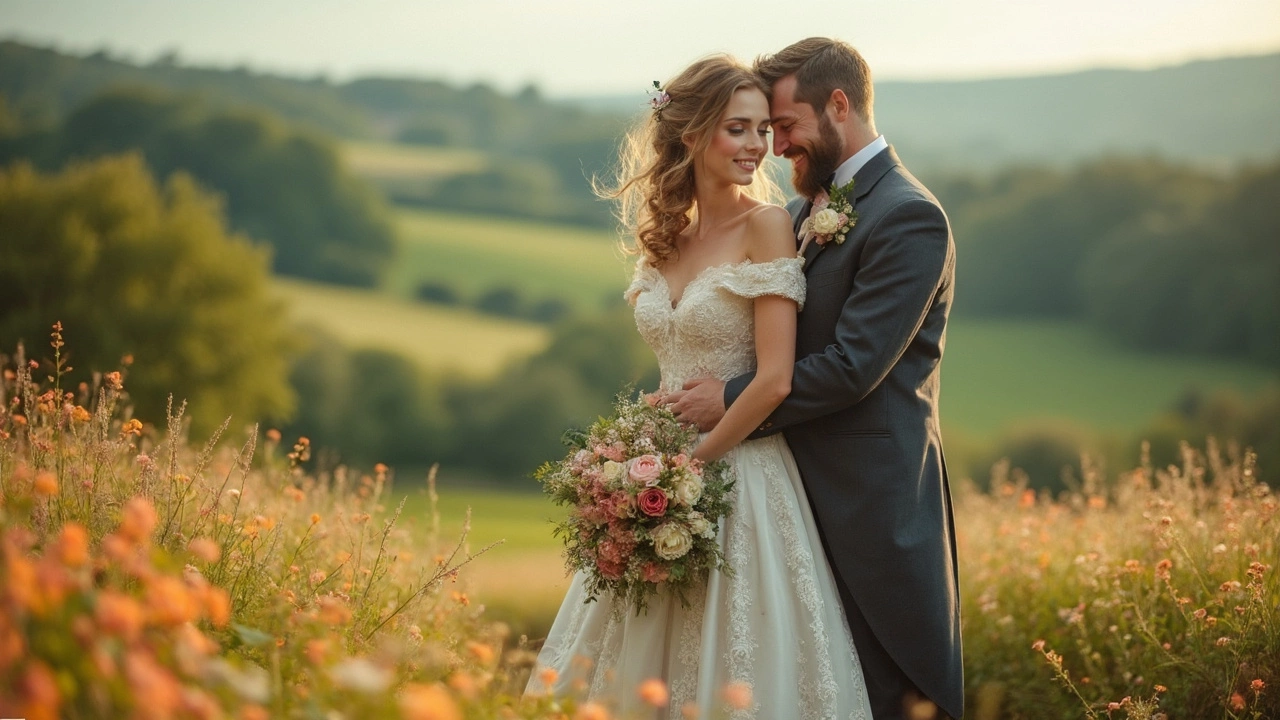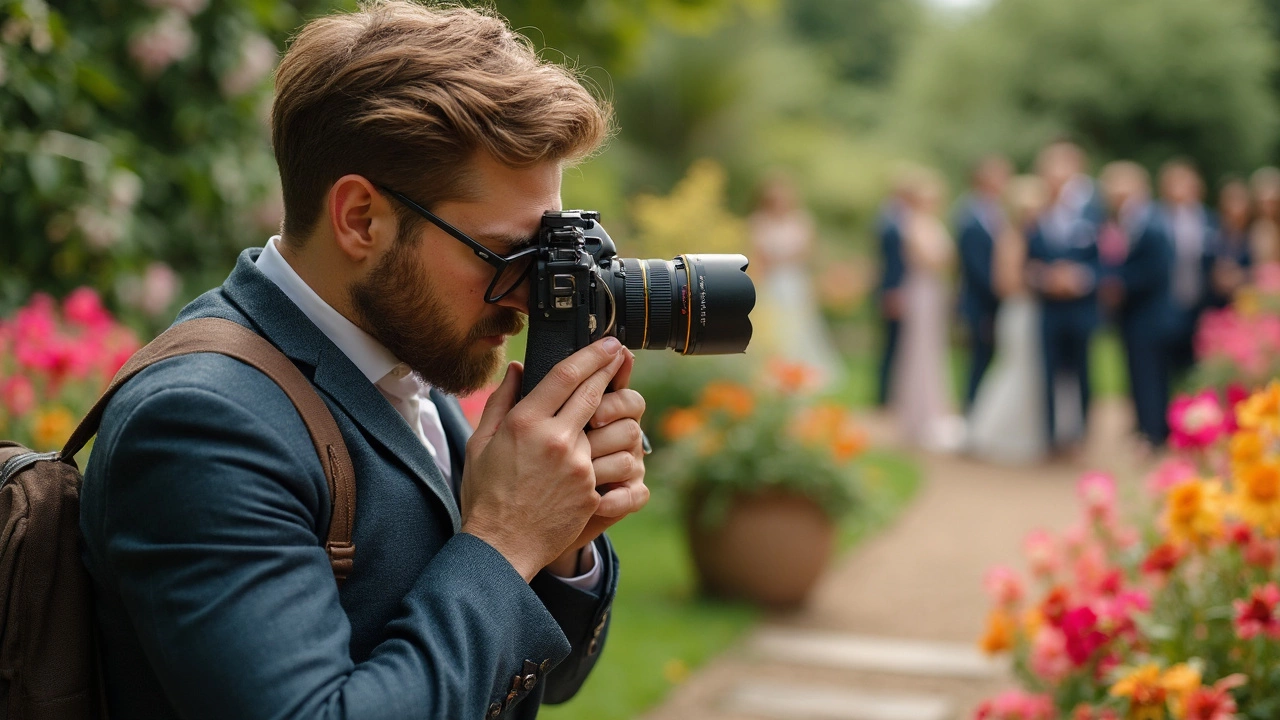What is a True to Color Photographer?
 Apr, 10 2025
Apr, 10 2025
So, you've got a wedding in the works, and you want those photos that pop with every vivid hue of that day! But what's the deal with 'true to color' photographers? These are the folks who make sure your photos reflect real-life colors. Imagine your bouquet's pink roses looking, well, pink—not some washed-out version. True to color photographers focus on this authentic color representation, which can make your wedding album timeless.
Now, why should you care? Well, those colors carry memories. Think of your pale-blue bridesmaids' dresses or the deep green grass at the venue. Seeing these details in their true shades helps rekindle how it all felt. Hiring someone who values color accuracy isn't just about art; it's about memory-keeping.
- Understanding True to Color Photography
- Why Color Accuracy Matters in Weddings
- Lighting and Color: The Dynamic Duo
- Editing Techniques for True Colors
- Choosing the Right Photographer
- Real-World Examples and Tips
Understanding True to Color Photography
True to color photography is all about getting the colors in your photos to match real life. If you've ever looked at a picture and thought, "Why does that look so different?"—it might be because the colors were off. In weddings, where every little detail matters, getting those colors right can make a big impact.
But, what's so special about true to color photography? It starts with the photographer's understanding of light and color balance. The goal is to make sure that the skin tones, flowers, and settings appear just like you remember them. This isn't just about snapping a pic—it's a skill that involves knowing how to work with light and shadows.
Photographers use calibrated equipment to ensure they're getting it right. This includes cameras that are set to capture a full spectrum of colors accurately. Some even carry color charts to check against while shooting. And trust me, this attention to detail makes a difference when the photos are printed or viewed on different screens.
Then there's editing. True to color photographers typically spend hours editing to present photos as naturally as possible. They focus on maintaining the integrity of the colors rather than applying trendy filters that might be tempting but can distort reality. You want those wedding photos to look good now and in thirty years, right?
Choosing a photographer who understands and values this approach can save you from disappointment when you open your wedding album. If you're someone who loves authenticity and wants your story told as it was, true to color is the way to go.
Why Color Accuracy Matters in Weddings
Weddings are filled with vibrant colors that tell the story of the day. Imagine recalling your wedding, and the colors in your album just aren't right. That's why true to color photography is so crucial. It captures colors as they are, not how a camera might misinterpret them.
Every color at a wedding has a purpose. The bride’s dress shade, the flowers in the bouquet, and even the groomsmen's suit hues have all probably been chosen with care. When a photographer gets these colors right, it keeps the visual narrative intact—almost like hitting the replay button on your special day.
Here's a cool fact: Natural light varies throughout the day, impacting color in photos. Early morning or late afternoon light, known as the 'golden hour,' casts a warm glow. True to color photographers have the skills to manage this shift, ensuring that what you see is exactly what your photos show.
Ever heard of color shifts? They happen when photos are edited too heavily, turning whites to blue or blacks to green. The key to avoiding this is subtle editing, which experienced wedding photographers understand. They know how to enhance without distorting, maintaining the natural beauty you loved on your special day.
True color accuracy isn't just about technical skills; it's a blend of understanding lighting, choosing the right equipment, and knowing when to click that shutter. For example, photographers use particular lenses and camera settings to avoid color distortion, especially in challenging light conditions.
| Light Time | Color Temperature (Kelvin) |
|---|---|
| Morning | 5000K - 6500K |
| Golden Hour | 4000K - 5000K |
| Midday | 6000K - 7000K |
You'd be surprised at how lighting and colors weave the day together. So, when you're hunting for a photographer, looking for someone who loves and respects these colors is a biggie. Your photo album won't just be a bunch of pictures—it's a vibrant story of your wedding, presented in the hues you held dear.
Lighting and Color: The Dynamic Duo
When it comes to nailing true to color photography, lighting is your best friend, or maybe your worst enemy if ignored. Natural light, with its ever-changing personality, can make or break your photos. It can wash out colors or turn whites into dreamy creams if managed poorly.
Shooting during the golden hour—in those magical times right after sunrise or before sunset—often brings out colors in the most flattering way. The softer hues at these times make skin tones look amazing and enrich the full color range. Photographers often put this time on a pedestal for a reason: it just works!
Now, indoor weddings bring their set of challenges. Here, photographers juggle between various lighting conditions. Flash is common, but it takes practice to avoid blasting intense light that can alter colors. Skillful use of diffusers can help, ensuring colors stay true under artificial light.
Remember, the post-editing process is where the magic happens. Well, it's actually a science. Adjusting white balance to maintain color accuracy becomes crucial. Some photographers use calibrated monitors and camera profiles to make sure what you see is what you get. This techy layer might sound nerdy, but it's the secret sauce to consistent results.
If numbers interest you, here's a quick breakdown of lighting's impact on colors:
| Time of Day | Color Temperature (Kelvin) | Effect on Photos |
|---|---|---|
| Daylight | 5500K | Neutral, balances colors nicely |
| Golden Hour | 3000K | Warm, enhances reds and oranges |
| Shade | 7000K | Cool, might add a bluish tint |
By understanding how lighting works with colors, you're already a step ahead in choosing or even guiding a wedding photographer who can capture your day as true to life as possible. It’s not just about clicking; it’s about making magic happen with every shot.

Editing Techniques for True Colors
Alright, stepping into the editing world, and it's like finding a treasure map! For a true to color photographer, editing isn't about adding filters or turning everything into a dreamy pastel. It's about bringing out the real colors that were there when you snapped that photo.
The first thing you notice is lighting correction. Fixing lighting issues is step one. If photoshoot lighting was a bit off, say under harsh sunlight, you'll see adjustments to balance it out, making colors pop as they did in person.
Then there's white balance. Ever notice in photos how whites sometimes look blue or yellow? Adjusting the white balance fixes that, making whites look truly white. This step is crucial because it affects all other colors in the photo.
Next up, saturation and contrast tweaking. The goal isn't to oversaturate and create neon colors. It's to give each hue a little boost, so it stands out without losing its natural charm. Photographers adjust contrast to define shapes and lines, preserving texture in your photos.
Ever heard of color grading? It's not just for movies! Even in wedding photography, subtle color grading can help achieve a cohesive look across your album, keeping those color accuracy vibes consistent.
Here's where a proper workspace comes in. Photographers need a color-calibrated monitor to ensure what they see on the screen matches what prints out. This is vital for true to color photography, as even the best editing won't help if your screen skews colors.
Oh, and let's not forget software! With tools like Adobe Lightroom, photographers can non-destructively adjust each element of a photo. This way, if they tweak something too much, they can always roll back changes without losing any original data.
Editing for photography tips isn't just technical, it's an art in itself. It's all about finding that sweet spot where tech meets the vivid memories of that wedding day. Every adjustment aims to honor the authenticity of the moment captured—no need for fancy tricks, just genuine color beauty.
Choosing the Right Photographer
Picking the perfect wedding photographer can feel daunting, especially when you're after those true to color images. Let's make it simpler. First, check their portfolio. Do the colors look natural, or are they more on the artsy side? You want someone who captures the world as it is.
Next, chat with your potential photographers about their process. Ask them directly about their approach to color accuracy. A true to color professional will have specific techniques to ensure every hue matches reality as closely as possible. They might mention lighting adjustments or personalized editing processes.
Consider lighting conditions. A key tip is finding a photographer skilled in various lighting environments, from the bright sun to dim receptions. How do they handle tricky indoor versus outdoor settings? Some photographers can adapt seamlessly, ensuring colors stay consistent, no matter where you are.
Let's cover editing styles. During your discussion, find out how much they alter colors during post-processing. True to color doesn't mean zero editing; it means careful calibration to represent reality accurately.
- Look for reviews and testimonials that mention color accuracy.
- Discuss your venue and see if they have experience there—it can make a big difference.
- Check their social media and web presence. True to color work tends to have a natural, effortless vibe.
Lastly, trust your gut. If their vibe and communication feel right, you're likely in good hands. With these steps, you'll be on your way to snagging a photographer who's a perfect match for your colorful day.
Real-World Examples and Tips
Alright, let’s dive into some real-world scenarios where true to color photography truly shines. Imagine this: you've planned a beach wedding, and you want every shade from the turquoise ocean to your bright orange flowers to look exactly as they did on your big day. A true to color photographer can nail this because they understand how natural light plays with colors, especially in outdoor settings.
Photographers like Jose Villa are renowned for maintaining color integrity in their work. Villa's beach wedding shoots capture the real hues of sand, sea, and sunset without any artificial tint messing things up. His technique involves shooting in natural light during the ‘golden hour,’ which is the first hour after sunrise and the last hour before sunset. These times provide the perfect lighting for capturing true tones without harsh shadows.
Let's talk about some practical tips to ensure you get the real deal:
- Discuss with your photographer about their approach to color accuracy. Ask to see previous work that compares photos to real-life settings to gauge their skill.
- During your consultation, bring color swatches of important elements, like your bouquet or bridesmaids’ dresses, to ensure your photographer understands the shades you're aiming to capture.
- Be mindful of the venue’s lighting. Artificial or mixed lighting can throw off colors. A good wedding photographer has ways to balance this using camera settings and editing.
- Inquire if they use editing tools like Lightroom to fine-tune colors without straying from realism. Lots of photographers share edited versus unedited shots, so ask for some comparisons.
Lastly, if you’re into numbers, here’s something cool. According to a survey by The Knot, 85% of couples said they regretted not investing in quality wedding photography with realistic color representation. Now, that’s something that hits home if you think about preserving those priceless moments.